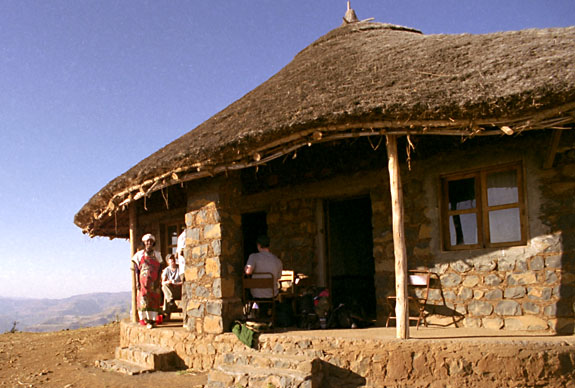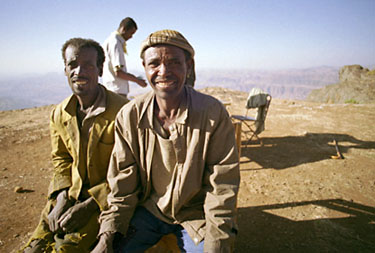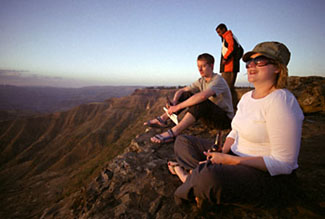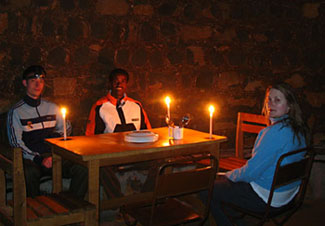Day 1: Sundown in Mequat Mariam
Mequat Mariam camp emerged on the horizon after a mere three hours' walk. The circular thatched huts called tukuls were modeled after traditional homes in the region, using materials donated by Save the Children UK and other charities. Inside however, we found clean, comfortable mattresses set into concrete hollows. The pretty bed covers were embroidered with traditional designs reminiscent of Lalibela's crosses. Candles and matches were provided to deal with the nighttime dark, although we were all prepared with flashlights.
Lining up to greet us, the polite staff welcomed us in English with great effort. I had misunderstood how the lodgings would work—I thought we'd be quartered in community homes but instead each community built these remarkable camps.

Single large tukul shared between us at Mequat Mariam. The manager is in the red apron.
 Our lovely guide (L) and main porter (R) from Mequat Mariam |
We'd been told to expect a "snack" upon arrival at each camp, but while in the awkward process of pulling off our dirty boots and stinky socks, the courteous manager materialized with an overflowing plate of "Meket pizza"—wheat-based injera spread with a tasty tomato-onion chutney. With unlimited servings of coffee or tea and not a hint of the sourness of tef-based injera, it was hard to avoid making a meal of it.
After a dusty couple of days, with hair still refusing to lay flat since the drive from Gondar, I ached for a shower. Striking a balance between the rural lack of running water and the foreigner's need for private upright bathing, a stall of wooden sticks with a door that didn't quite close was set some distance from the tukuls. The staff filled the canvas waterproof bladder large enough to wash two people with conservative usage. Water dripped rapidly upon turning the knob, so ideally, bathers would turn it off while soaping up. Rather chilly despite TESFA's romantic description of sun-warmed water, especially in the cooler air temperatures of December. But with the sun shining and views of the valley below through the spaces in the stall, it was a beautiful way to get clean.
 Sundown beer on the "rock bar" |
 Candlelit dinner - first night! |
Our candlelit dinner was served in the dining tukul around 7:30, while we were still quite full of Meket pizza. At 3000 meters, the night was so cool we arrived at dinner wrapped in our jackets, gloves, hats and scarves, but the campfire inside the room had the desired effect. To our delight the meal was injera-free: a scrumptious vegetable soup, a potato-based sauce with chicken and a spinach wat with rice.
Everything was tasty and hot, prepared in a separate cooking tukul. I've always been disinclined toward safari-type hyper-luxury accommodations in the African bush, but our first night at Mequat Mariam proved that TESFA's organizers understood how to provide its paying clients with relative indulgences in an appropriate way.